How to Choose a Backcountry Campsite (that follows Leave No Trace)
Want to find a picture-perfect backcountry campsite? Here are all the things I look for when selecting a campsite on a backpacking trip.

After a long day of carrying a heavy backpack on the trail, I know what it’s like to just want to set up your tent, make dinner, and fall asleep. When you finally reach the point where you’re going to set up camp for the night, you might be tempted to just take whichever spot is closest without a second thought.
If you’re new to backpacking, you might also wonder: Is it ok to camp next to the water? What about setting up your tent in vegetated areas where the ground might be softer? Or what happens if it’s late and you can’t find a campsite? Can you camp right on the trail? As someone who got into backpacking in my early adulthood, I remember wondering the same things during my first backpacking trips.
As more people are getting out and enjoying the outdoors, I want to share with you the details of how to choose a campsite that’s beautiful and comfortable while minimizing your environmental footprint. By following Leave No Trace best practices, the wild places that you and I love can be preserved for future campers.
In this blog post, I share the how to choose a campsite while backpacking so you can go into your next trip with confidence on where (and where not) to sleep at night.
This post may contain affiliate links.
1. Research before you go
Anytime you are going backcountry camping, you are responsible for learning the regulations as an important step in planning a backpacking trip. There really is no excuse for not knowing the regulations.
On some popular trails, like the Four Pass Loop Trail in Aspen, you are only allowed to camp in designated campsites that you have a specific permit for. In other areas, like Kings Canyon National Park, you are only required to camp a minimum of 25 feet from the water, but you must stay in designated, previously used sites.
Here are some things to look out for as you are researching the trail.

Save this post!
Enter your email & I'll send this post to your inbox! You'll also receive my weekly newsletter full of helpful advice for planning your adventures.
2. Choose a flat, bare, stable surface
When looking for a campsite, you want an area that is flat and durable such as rock, sand, dry grass, or compacted dirt. Here are some other considerations to keep in mind before you pitch your tent.
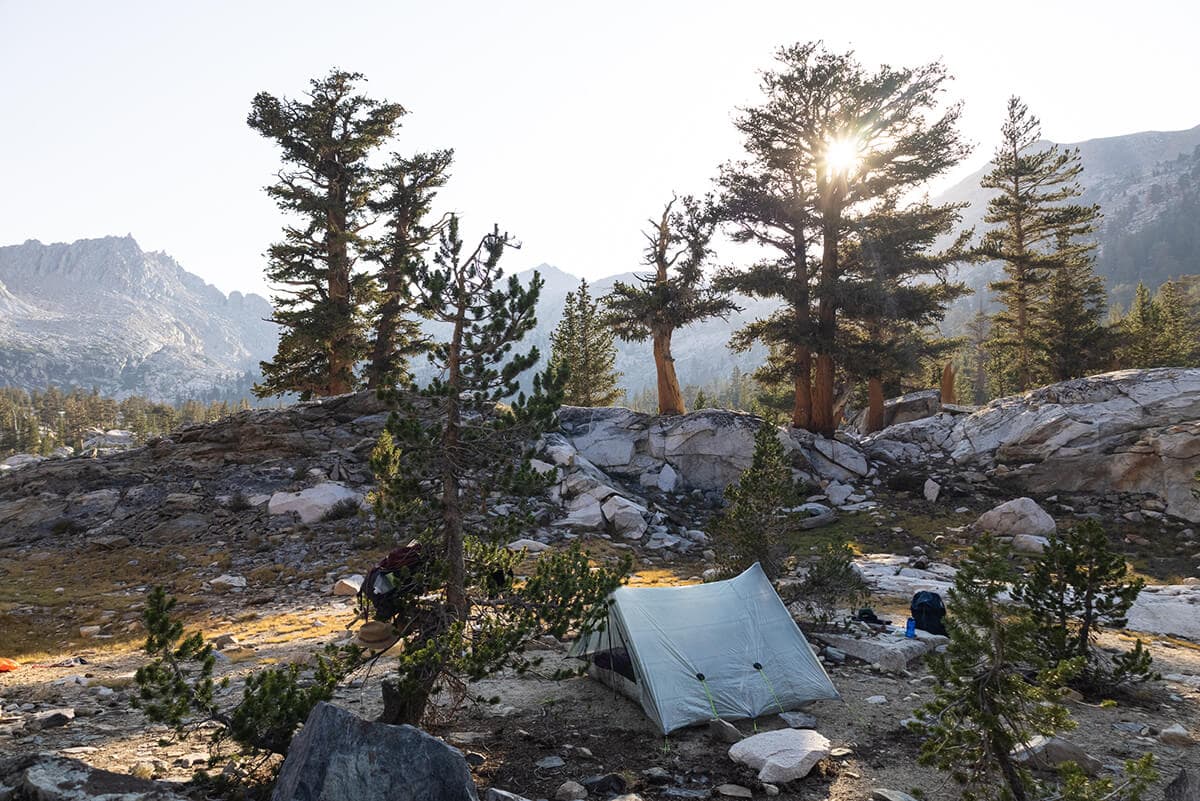
3. Don’t camp too close to water sources
While it’s always best to camp where you have access to a water source for drinking and cooking, you don’t want to set up your tent right on the water’s edge, whether that’s a river, lake, stream, pond, etc.
On time while backpacking in Idaho’s Sawooth Mountains, I came across an illegal campsite that was directly on the trail and also inches from the water. This violates several principles of Leave No Trace and the regulations listed on the wilderness permit that each group is required to sign and carry that states that you must camp at least 100 feet from the water.

You can of course hang out on the water’s edge, but setting up your tent like this person did blocks access to the lake for wildlife and other campers who might need to filter water. It’s pretty selfish if you ask me.
Here are some tips for choosing a campsite that’s near, but not too close, to a water source.
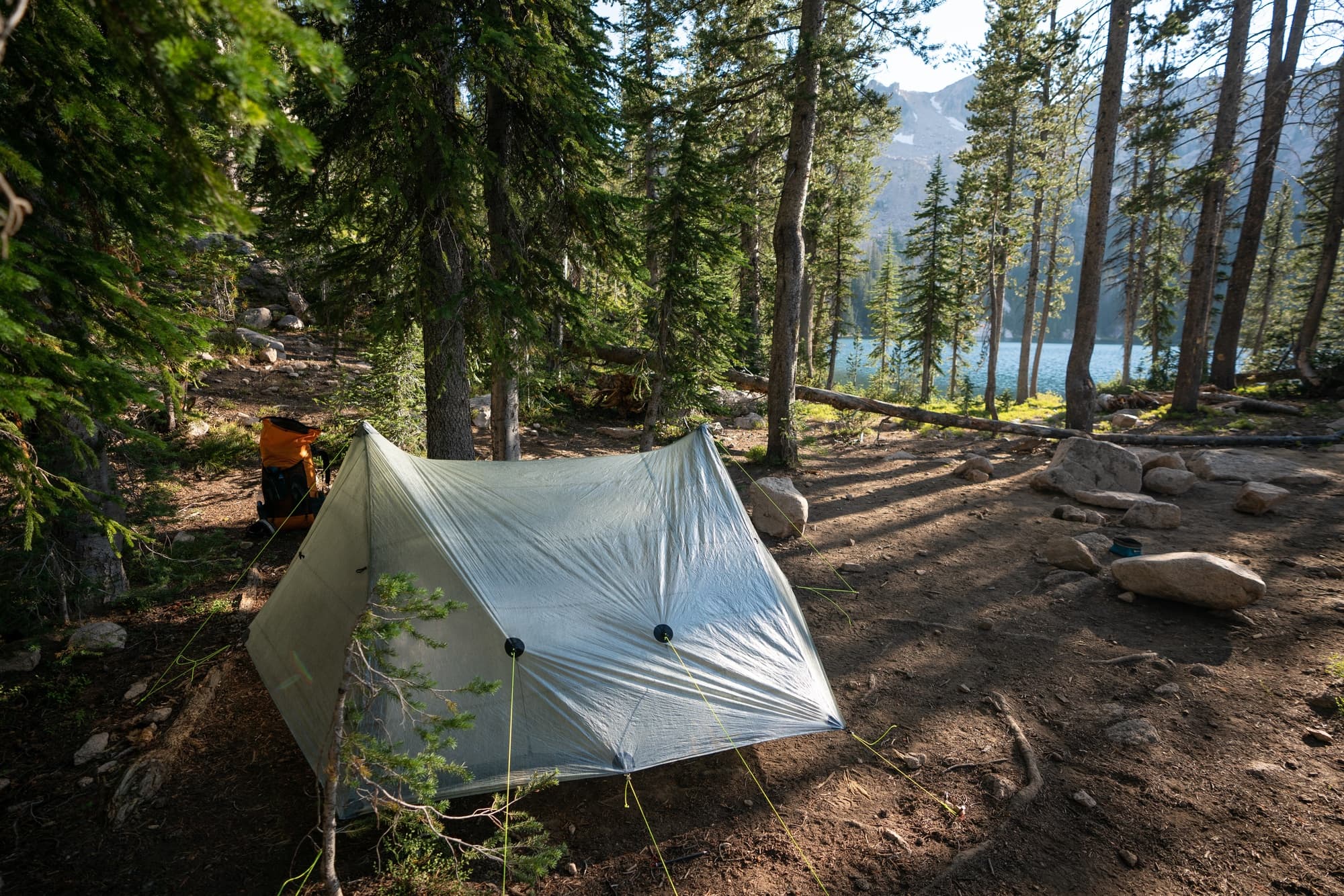
4. Be Respectful of Others
One time when I was backpacking in the Wind Rivers, we found an amazing campsite after a 10 mile day, only to be kept awake until midnight from rowdy neighbors across the lake. It was so annoying!
When I’m camping, I always remind myself of the golden rule – me having a good time shouldn’t affect anyone else’s ability to have a good time. Here are some ways I ensure that I’m being a good campsite neighbor and respecting my fellow campers while backpacking.

5. Be aware of hazards
I’ve made the mistake of setting up my tent too close to some dead trees before. The wind picked up in the middle of the night, and I was so paranoid that a dead branch was going to fall on me that I barely got a wink of sleep.
When you are selecting a backcountry campsite, you want to look around and see if there are any hazards to avoid:

6. Think about the sun
If you are up in the mountains in chillier temperatures, you may want the warmth of the sun on your tent first thing in the morning. Or perhaps you’re in the desert where it’s hot, and you want to be in the shade as long as possible.
When figuring out the exact placement of your tent, you’ll want to consider where the sun rises and sets. Then set your tent up near trees or big boulders that will block the sun from hitting your tent at the hottest times of day.

7. Minimize the Impact of Your Campfire & Campsite
While these days I’m way too paranoid about wildfires to have a campfire while backpacking, if you want to have a campfire, your first step is to make sure they are even allowed. In many wilderness areas or during seasonal fire bans, campfires are illegal, even if they are in an existing fire ring.
If you find out that campfires are allowed and you’re set on having one, here are a few things to look for when choosing a campsite.
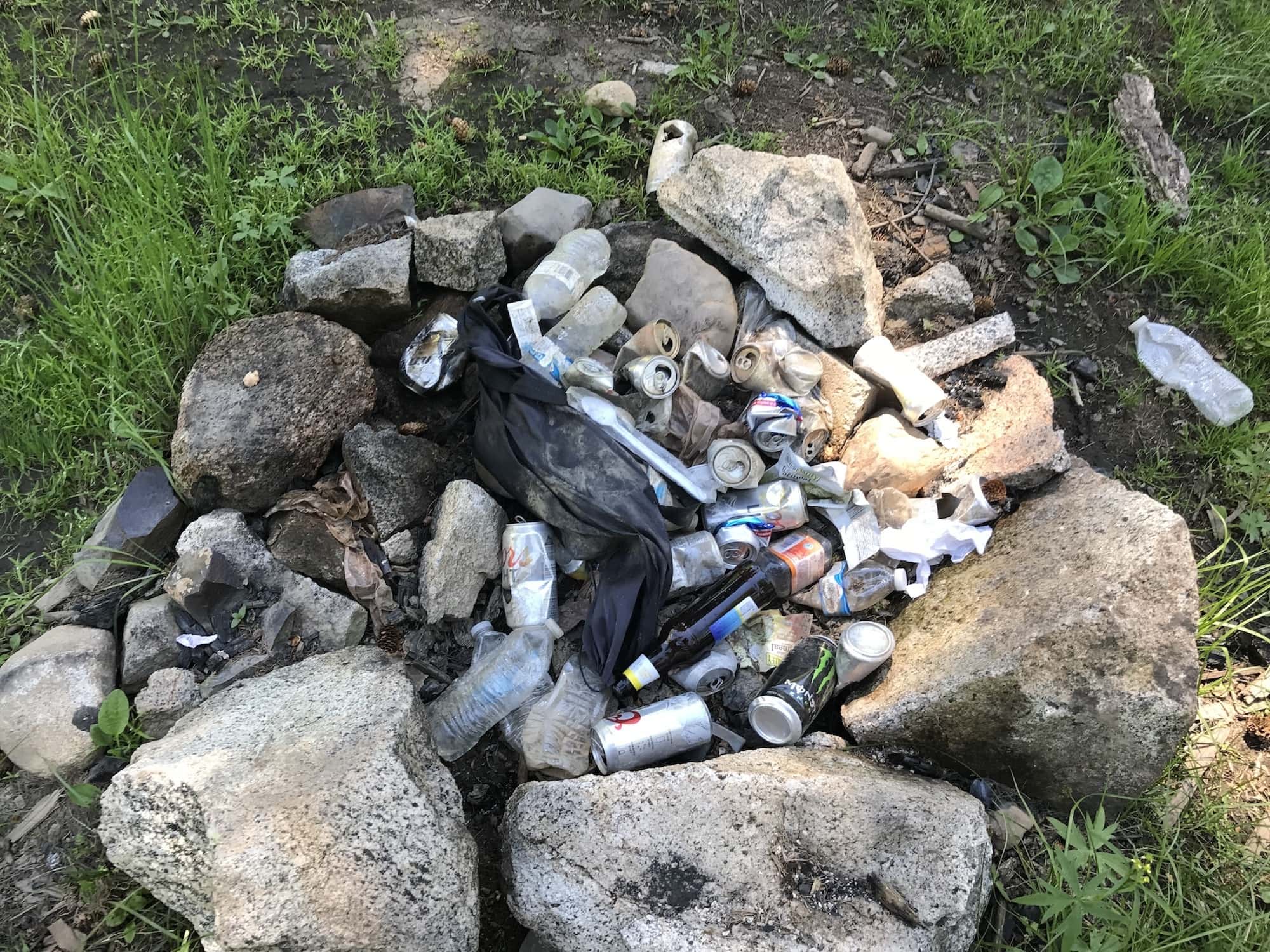
Frequently Asked Questions
Backcountry camping means you have to walk on a hiking trail to a campsite in the wilderness. Since you cannot drive to backcountry campsites, you have to carry all of your gear in a backpacking pack.
What are some of the key factors to consider when choosing a campsite while backpacking?
The biggest factor to keep in mind is to ensure you’re in a legal and pre-established campsite. Then, I look for campsites that are flat, dry, safe, and comfortable, ideally one that’s slightly elevated to avoid pooling water if it rains. I like to be near a water source if possible, but I make sure to camp at least 200 feet away. Finally, I make sure that I’m off of the trail and respecting the space of any neighbors who have already set up camp by camping as far away as I can from them.
To keep wildlife away from your campsite, make sure you store your food and scented items properly. Depending on where I’m backpacking, I use either a bear canister or hang my scented items and food in a bag from a tree. I keep the canister or bag at least 100 feet from my campsite. Another good practice is to cook and eat away from your tent to keep food odors from attracting wildlife to your tent.
Before you head off to the trail, you should have a backup plan of where you’ll camp if your first choice doesn’t work out. Print out a map so you can use it to help you find alternative campsites and stay flexible. If you’re stuck, you could try asking the people at the campsite you wanted if they know of other good spots nearby.
More Backpacking Tips
Save this post to Pinterest
What would you add to my tips on how to choose a campsite? Let me know in the comments below!

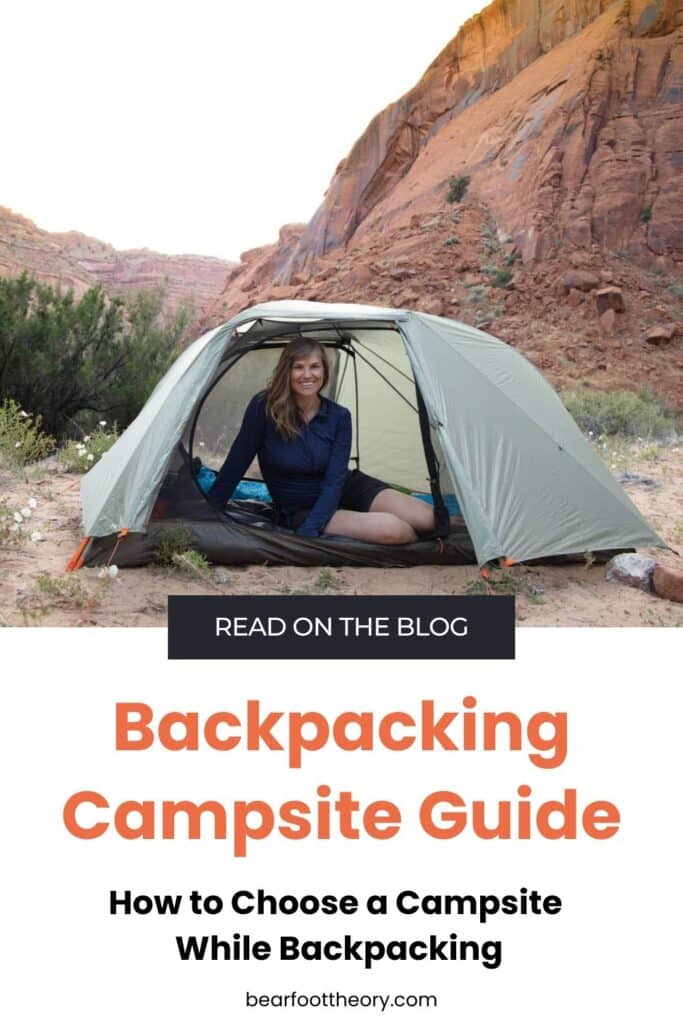
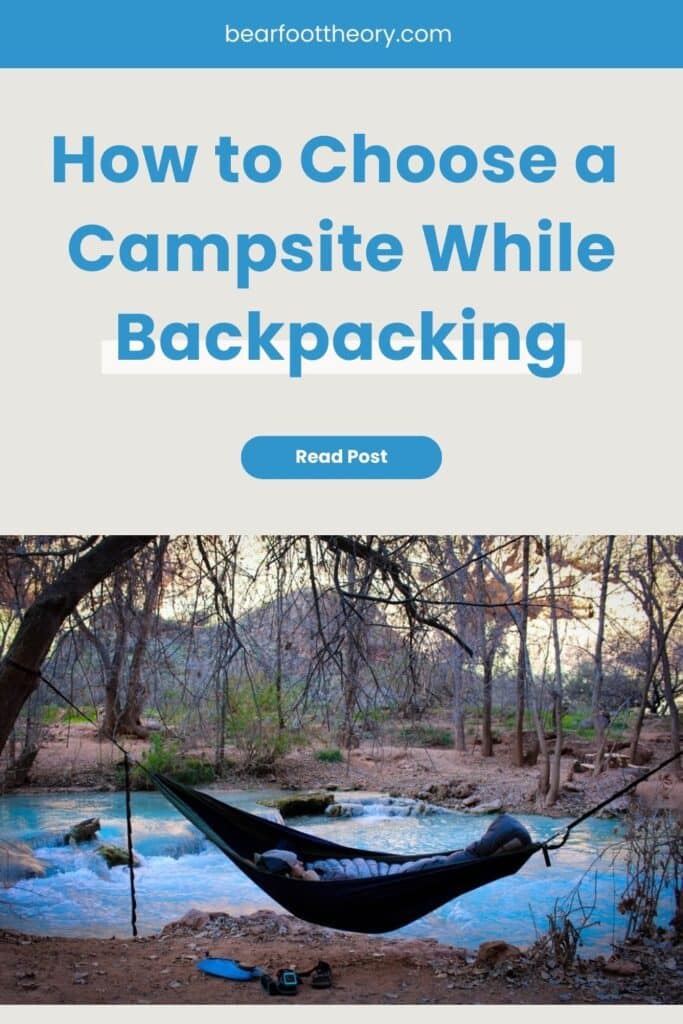
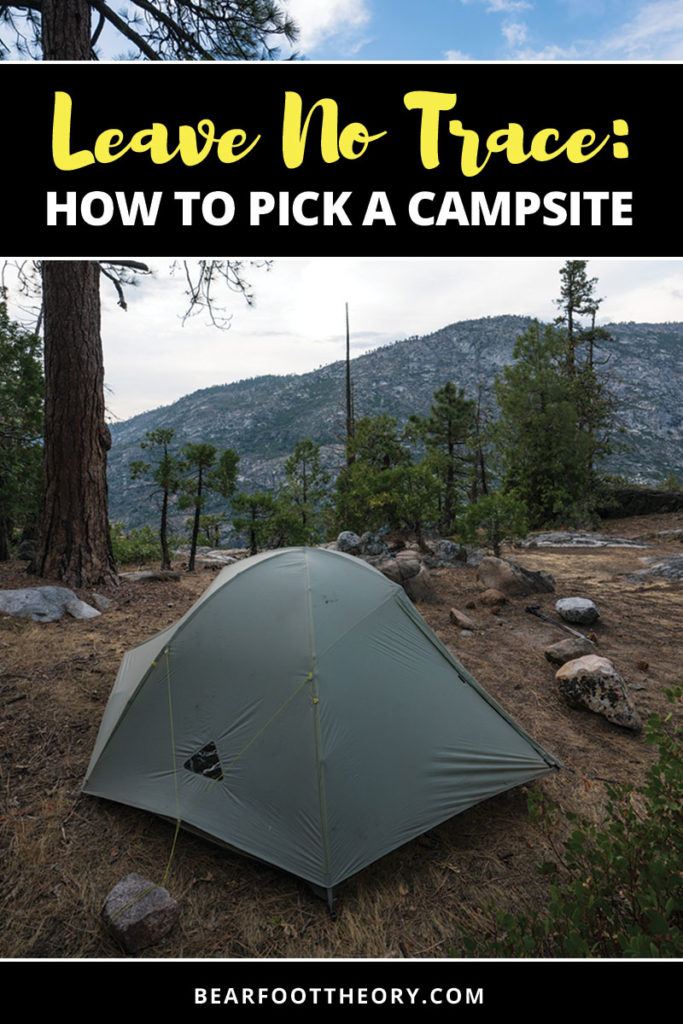
Nice post! Thanks for sharing!
We try to pack our food in reusable containers so that the plastic waste is minimal. Whatever waste we do have, we take with us. That way we leave no waste. Food waste that is biodegradable is put into a hole and covered up.
You can chuck sand on your fire to make sure that it is completely out.
What do you do with your Waste?
Hello Elnore, we pack it out. We actually have a full post coming soon on how to reduce waste while car camping, stay tuned for it.
Nice tips for picking the best camping site. It will help out many people who love camping and looking for the site. Thanks
I appreciate that you pointed out that, whenever possible, it’s important to pitch your tent or park your RV in an existing campsite. I think one of the great things about camping is being able to be completely surrounded by nature, but still have a comfortable place to sleep. I think campsites that are already set up offer a good way to still get the nature experience, still be comfortable enough to sleep, and get the bonus that you’re not destroying any nature by being there.
Hi Kristen,
Nice post! Good read.
Thanks for sharing your views on choosing a campsite. Your post is quite interesting. I loved it especially the fourth point, Be respectful to others.
I have a camping trip next month. It is meaningful for me to follow your tips. Great thanks!
Nice post! Good read.
that’s quite a lot of information. Thanks for the post and sharing your experience
particularly useful information for me. I appreciate that you pointed out that
I am completely new on your blog, and I enjoyed what I have read.
Welcome, John! Thanks for reading 🙂
Hi there! I just read your article on “How to Pick a Campsite and Leave No Trace” and I must say, it was a great read! Your tips on how to find the perfect campsite and how to minimize our impact on the environment were so informative. I especially liked the advice on how to select a site that’s far from water sources and trails to protect the ecosystem and avoid disturbing other campers.
I’ve been camping for a while now, and I always thought that as long as I clean up after myself, I’m leaving no trace. But after reading your article, I realized there’s so much more to it. I never thought about the importance of spreading out our impact by camping at established sites and avoiding sensitive areas like meadows and alpine zones. And your suggestions on using biodegradable soap and food containers were such simple yet effective ways to minimize our impact even further.
Thanks for putting this together, it’s amazing how a few small changes can make such a big difference in preserving our wilderness areas for generations to come. Keep up the great work!
Hi Alex, so glad you found this blog post helpful! Leave No Trace is an evolving practice but it’s more important than ever. Enjoy your next camping trip!
Hi there, I just read your article and I wanted to take a moment to say how much I appreciated it. Your tips for finding the perfect campsite and leaving it better than we found it were spot on. I especially liked the suggestion of choosing a spot that’s already been used, as it minimizes the impact we have on the environment.
Your emphasis on Leave No Trace principles really resonated with me, as I believe it’s our responsibility as outdoor enthusiasts to do everything we can to preserve the beauty of our natural spaces. Your reminder to pack out all of our trash, properly dispose of human waste, and respect wildlife was a great reminder of the small things we can all do to help protect the environment.
I also appreciated your suggestions on how to make a campsite more sustainable, such as using reusable dishes and utensils, and choosing a camp stove that uses alternative fuels. These are things that we can all do, no matter how experienced we are, to make a positive impact on the environment.
Overall, I thought your article was informative, well-written, and highly relatable. Thanks for sharing your passion and expertise on this important topic! Keep up the great work!
Hi Anthony, thanks for the kind review and glad you found this article so helpful. Enjoy your next camping trip!
It was wonderful that you advised keeping in mind that other campers are there to appreciate nature, just like you, whether you are staying at an established campsite or opting for dispersed camping. Next week, my husband and I are taking a camping trip in an RV to explore and discover good spots around the country. Based on your suggestions, we will locate an RV park campground so that we can rest and take in the day while our 6-year-old kid plays.
Hi Lily, sounds like a great plan. Enjoy your trip!
My cousins and I recently rented a motorhome since we were planning to go on a camping trip later this April. I’m glad you mentioned doing as much research as possible before going on our camping trip since there is no excuse for not knowing the regulations of the campsite we are considering. I’ll be sure to do so once we have decided on an RV park to go to for our camping trip soon.
Thanks Elina – enjoy your trip!
My friends and I have decided to go camping at the end of this month, so we need to find a campground soon for our trip for us to book it in advance. It was a helpful tip when you told us to choose a campsite that is at least 200 feet away from a trail or body of water to make it easier for us to access water when needed. I’ll be sure to keep this in mind while I look around campgrounds available in Florida for us to consider for our trip.
Great post! Camp Boa sounds like an incredible destination for adventure enthusiasts. Have you considered discussing the variety of activities available at Camp Boa? It would be fascinating to hear more about the hiking trails and wildlife encounters that make this place so unique. Looking forward to your next update!